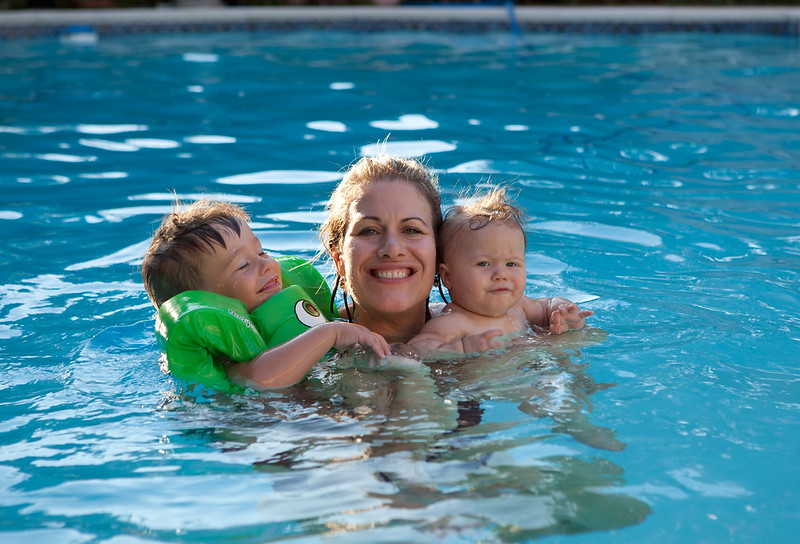Swimming is a fun activity for your kids that helps them stay active but also poses dangers. Understanding water safety is paramount to ensure everyone can have a good time while splashing in the sun. Read below as our Crème de la Crème of Lincoln Park team explores a few tips for keeping your children safe in the water.
Why Is Water Safety Essential?

Pool hug by Lars Plougmann is licensed with CC BY-SA 2.0
Drowning is the leading cause of death for children in the United States. More children ages 1 to 4 die from drowning than from any other cause, often in a backyard swimming pool. Drowning is the second leading cause of death for children ages 5 to 14, resulting in more deaths than injuries sustained in motor vehicle crashes. A study from the United States Consumer Product Safety Commission found a steady rise in fatal child drownings, with an average of 379 children drowning in pools and spas yearly.
What Water Safety Guidelines Can Protect Your Kids?
There are several safety tips you can follow to keep your kids safe while enjoying the water in Lincoln Park, including the following:
Install a Pool Fence
According to the Centers for Disease Control and Prevention, installing four-sided fencing could prevent more than half of all drowning deaths of young children. Fences should be at least 4 feet high to be the safest and provide the best protection. Fence gates must have latches high enough to be out of the reach of children. The gates should open outward and be self-latching.
Arrange for Swimming Lessons
If you or your children don’t know how to swim, it’s important to learn how. You can then protect your kids from drowning, and they can swim safely. The USA Swimming Foundation is an excellent resource for finding low-cost or free swimming lessons in and around Lincoln Park. Just type in your zip code to see all the classes in your area.
The Chicago Park District has an aquatics program where your child can take swimming lessons. Kids (accompanied by a caregiver) ages 6 and up will start with basic swimming techniques and gradually move to more advanced swimming. Or if you have little ones 18 months to 5 years old, you can take them for the Tiny Tot Swim, with three levels of instruction available. They’ll learn everything from adjusting to the water to basic swimming skills.
Ensure Proper Supervision
Even if your child knows how to swim, you must remain vigilant. Your child can slip and fall, get tired while swimming, or play dangerous games in the water, such as holding their breath. If you’re having a party around your pool, consuming an alcoholic beverage may be tempting, but it’s vital not to drink while supervising your kids.
Take Extra Safety Measures
Seek an additional layer of safety. If you’re taking your kids swimming at a public pool or beach, try to find one with a lifeguard on duty for an extra set of eyes. Lifeguards are also highly trained and can assist anyone in trouble in the water.
Designate a Water Watcher
Don’t assume everyone else is watching the kids when a gathering occurs, such as a pool party or backyard barbecue. The other adults may believe the same thing, leaving your children vulnerable. So designating a water watcher is essential.
Ensure the water watcher is an adult who won’t look away from the children in the water. They shouldn’t read, text, converse, or participate in other activities while watching the kids. Adults can take turns to ensure continuous supervision. Even kids who’ve had swim lessons need careful supervision when being near water.
Talk To Your Kids About Water Safety
Teach your children not to enter or play in pools, spas, bathtubs, hot tubs, jacuzzis, decorative ponds, fountains, or buckets unless you or another adult are present.
Make Bath Time Safe
The bathtub can be as dangerous as a pool, especially for smaller children who can easily slip below the water line. Never leave your child unattended in a bathtub. Bath time is another excellent opportunity to talk to your child about water safety and its importance.
Use Proper Safety Devices
Only life jackets offer proper protection in the water. Water wings, floaties, noodles, or inner tubes aren’t suitable substitutes, and air-filled or foam toys don’t provide safety or protection from drowning. Don’t substitute toys for a life vest.
Learn CPR
Knowing CPR is imperative, as you may be able to save your child’s life before the paramedics can arrive. You can participate in CPR Training with the Red Cross near you.
What About Outdoor Water Safety?
Beware of additional risks in natural bodies of water. Lakes, rivers, and oceans pose different dangers to children, as they often have hazards, such as dangerous currents or waves. There may also be vegetation, rocks, and limited visibility. Weather conditions can change rapidly, causing strong winds, dangerous flash floods, and heavy rains, including thunderstorms with lightning strikes. So it’s important to check the local forecast before your family heads out for any activities in, on, or near water, including boating, canoeing, kayaking, paddleboarding, tubing, or surfing.
Keep Your Kids Safe in the Water in Lincoln Park
It may not always be obvious when your child is in distress in the water. You might think that if your child were drowning, you’d hear splashing or cries for help, but this isn’t always the case, so don’t rely on such signs. Your child can slip beneath the water without a sound. Drowning can happen quietly and quickly. So remain vigilant and don’t rely on your ears to alert you to possible danger. If you’re visually impaired, make sure someone else is present with you to watch the children.
Our Crème de la Crème of Lincoln Park team knows how important it is to learn about and practice water safety. Make sure your children know how to swim and follow safety guidelines as a family to help keep your kids safe while you enjoy your time in the water together.
